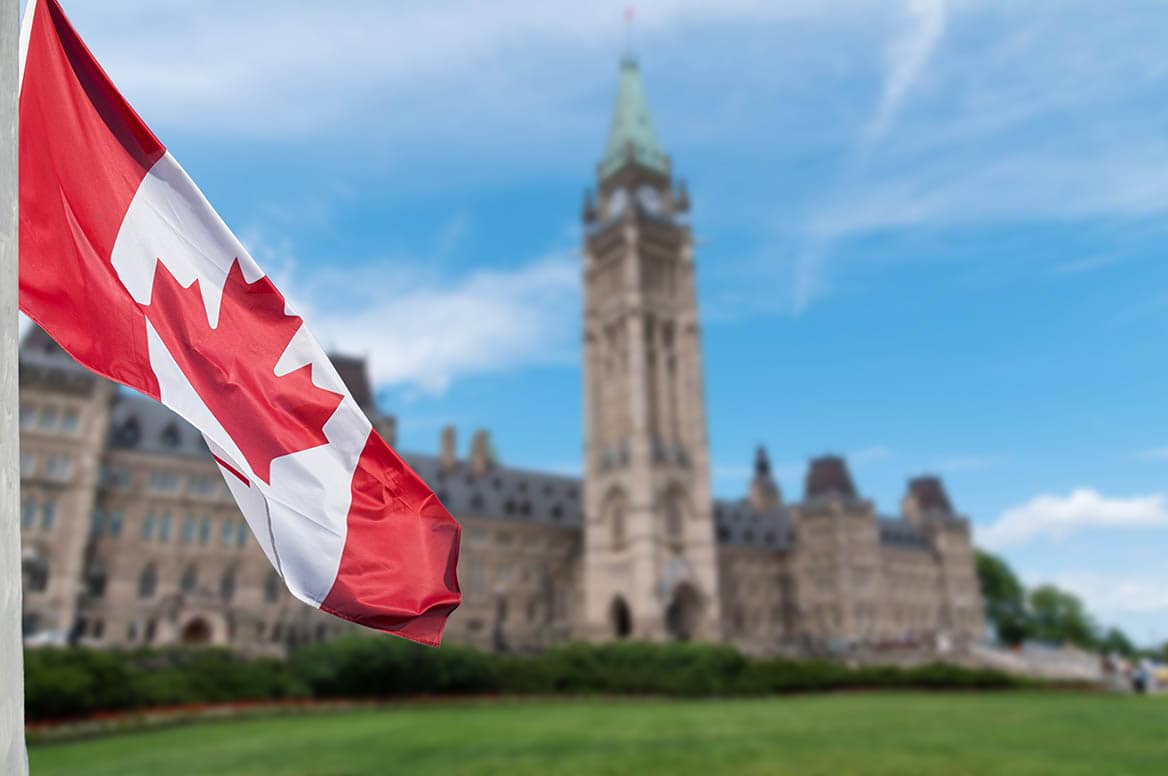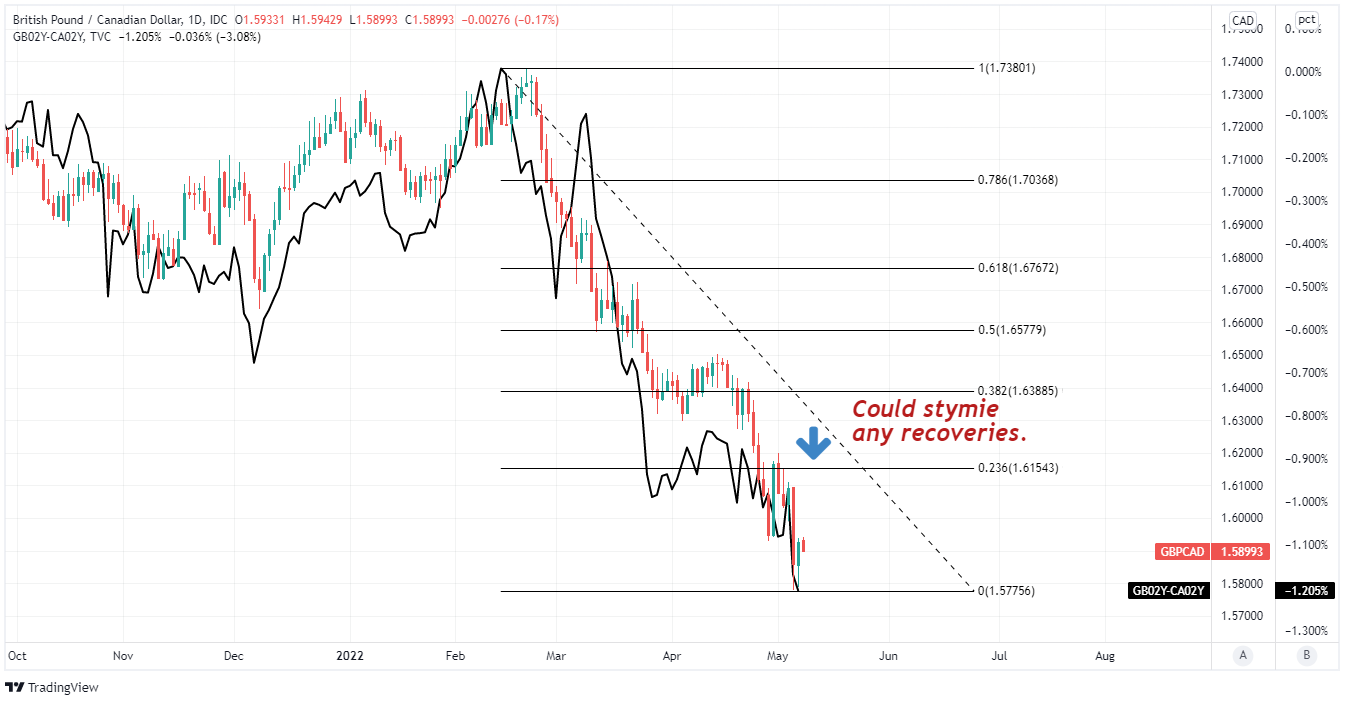GBP/CAD Week Ahead Forecast: Looking for a Foothold
- Written by: James Skinner
-
- GBP/CAD could find a footing near 1.58 short-term
- But struggle to sustain any recovery above 1.6100
- USD trend, U.S. CPI & UK's Q1 GDP data in focus

Image © Adobe Stock
The Pound to Canadian Dollar exchange rate tumbled to a five year low following last week’s Bank of England (BoE) monetary policy decision but could find a footing above the nearby 1.58 handle this week if the Loonie cedes further ground to the U.S. Dollar in the days ahead.
Canada’s Dollar ended the week on its back foot following a softer-than-expected April employment that came in contrast to the stronger-than-expected reading from across the southern border in the U.S., which helped lift the all-important USD/CAD rate comfortably above 1.29 ahead of the weekend.
Friday’s extended rally in USD/CAD enabled GBP/CAD to climb monetarily from five year lows and would potentially help Sterling onto a firmer footing above 1.58 if sustained through the week ahead.
“In Canada, there’s no market moving economic reports on the calendar, so financial market volatility will be following along for the ride with what happens in the US and abroad. Earnings reports are now a very mixed bag,” says Avery Shenfeld, chief economist at CIBC Capital Markets.
“In the US, although the 12-month CPI will actually get a bit of a breather due to both base effects and softer energy prices, that will be cold comfort if, as we expect, monthly core prices comes in at a firm 0.4%,” he also said on Friday.
Above: Pound to Canadian Dollar rate at daily intervals alongside GBP/USD and spread - or gap - between 02-year UK and Canadian government bond yields and Fibonacci retracements of February fall indicating likely short-term technical resistances to any recovery. Click image for closer inspection.
The upward trajectory of the USD/CAD matters for GBP/CAD because the latter always tends to closely reflect the relative performance of Sterling and the Loonie when each is measured against the U.S. Dollar.
This leaves a lot to be determined by Wednesday’s U.S. inflation figures and the resulting impact on market appetite for the U.S. Dollar ahead Thursday’s first-quarter GDP data from the UK.
“The week ahead is very light on the data domestic front, meaning somewhat random external factors (volatility, the broader USD tone, flows) will continue to shape CAD trends,” says Shaun Osborne, chief FX strategist at Scotiabank. (Set your FX rate alert here).
“Our week-ahead range estimator and fair value model both suggest downside risks for the CAD but we do think that relatively elevated commodities plus a resilient domestic economy (despite the softer than expected Canadian jobs report today) should limit downside,” Osborne also said on Friday.
Some measures of consensus suggest the more important rate of core inflation is likely to have accelerated from 0.2% to 0.4% in month-on-month terms in the U.S. during April in what would be an unhelpful outcome for those in the market who may be looking for signs of inflation topping out.
Above: USD/CAD shown at daily intervals.
Such signs are crucial if the Federal Reserve is to be kept from raising its interest rate in the 0.75% increments that were at least temporarily ruled out in last Wednesday’s press conference following the bank’s May monetary policy decision, which is in turn important for the USD/CAD outlook.
“I think expectations are that we’ll start to see inflation flattening out er, and er, not necessarily declining yet but we’ll see more evidence, we’ll see some evidence that core PCE inflation is perhaps either reaching a peak or flattening out,” Fed Chairman Jerome Powell said last week.
“I think we really need to see that our expectation is being fulfilled. That inflation is under control and starting to come down. But again, it’s not like we would stop. We would just go back to 25 basis point increases,” he also said in the Wednesday press conference.
Wednesday’s inflation figures are a potential upside risk for both USD/CAD and GBP/CAD ahead of Thursday’s UK GDP data, which consensus suggests is likely to reveal that the economy stalled in March after growing by around 1% during the opening quarter.
A one percent first quarter growth rate would be faster than the 0.9% projection included in the May forecasts from the BoE last week and could be enough to earn Sterling a moment of respite from recently heavy selling pressures.
However, and in the interim, the Pound to Canadian Dollar rate could also potentially benefit if the deteriorating economic backdrop in China further undermines global market risk appetite as this would likely keep U.S. Dollar exchange rates buoyant and commodity-linked currencies under pressure.
This is after China’s Premier Li Keqiang was widely reported at the weekend to have called a step-up in authorities’ efforts to save jobs and support households as they grapple with the fallout from coronavirus containment measures in major metropolitan hubs including Shanghai and Beijing.
Nonetheless, the Scotiabank team doubts that the Pound to Canadian Dollar rate will be able to recover by much in the immediate period ahead.
"Like other CAD crosses, the CAD bull move remains well-rooted on this cross and the deeply-entrenched trend signals - bearish for the GBP - do not really allow for any sustained GBP rebound at this point," says Juan Manuel Herrera, a Scotiabank colleague of Osborne.
"Gains through 1.65+, which remains very distant, are needed to signal a sustained GBP rebound at this point, we believe. Minor GBP gains remain a sell from a technical point of view," Herrera wrote in a review of GBP/CAD's charts last Tuesday.


